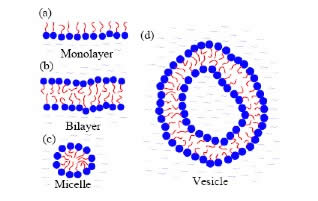 Group Members Group Members 
|
 |
Javier Sacristan
|
 Email:
Email:
Duration in group: 2005 - 2007
Research Summary
The segmental dynamics on polymer blends
During my stay we studied segmental dynamics on
polymer blends as a function of effective concentration leaving all other
variables constant. To accomplish this objective,we investigated the
relationship between the effective concentration and dynamics in
poly (ethylene oxide) [PEO]/poly (methyl methacrylate) [PMMA]
homopolymer and diblock copolymer blends. Molecular dynamics
simulation allowed us to measure both effective concentration
and self concentration, neither of which is accessible experimentally,
and to monitor the resulting dynamics as a function of local volume size.
The copolymer self-assemblies
Amphiphilic molecules are characterized by the feature that they contain both
water "loving" (hydrophilic) and water "hating" (hydrophobic) structural units.
Familiar examples are alcohols or lipids. Amphiphiles are important for many
applications in technology and nature. They are very effective at helping to
dissolve different substances in water, which makes them very useful, e. g., as
detergents, or as coating materials to stabilize colloidal systems. Because of
the hydrophobicity of one of the blocks the amphiphiles self-assemble in such a
way as to minimize the contact between the tails (hydrophobic) and the solvent.
The nature of the self-assemblies, of course, depends on a number of factors
such as the chemical composition of the block copolymers, the polarity of the
solvent and the relative solubility of the blocks in the solvent.
Super-molecular aggregates, such as micelles, vesicles, etc. are typical
example of such self-assemblies.

These structures may then order on an even higher level and form
superstructures. Particular interesting from an application point of view are
those phases where the material is filled with bilayers. Such bilayer interfaces
can serve as barriers against the diffusion of particles, and help to divide the
space into compartments. Indeed, lipid bilayers are the structural basis of all
biological membranes, which in turn play a central role for the function of all
cells and cell organelles. It is obvious that investigation of the aggregation
behavior of the diblock copolymers has both theoretical and practical importance
because of their conventional and potential applications in bio-materials,
optics, microelectronics, thermoplastic elastomers, pressure-sensitive
adhesives, colloidal dispersants, compatibilizers of polymer blends, foams, and
surface modification.
From an experimental point of view, studying the properties of biomembranes
on a molecular scale in situ is not an easy task. So computer simulations result
very helpful to study membranes and can contribute to an improved understanding
of physical phenomena on that scale.
In this project
we investigate through computer molecular dynamic simulations
by means of different models, united atom (UA) and coarse grain (CG) models,
diblock copolymer solutions in water. Molecular dynamics (MD) simulations on
fully atomistic models are not possible because the timescale for spontaneous
self-assembly is too long (microseconds) and because the system sizes are too
large (many hundreds of thousands of atoms) to be routinely studied using
currently available computers. So, UA models are used such an intermediate step
in order to obtain the parameters needed for the CG simulation. Those (CG)
models are particularly suited to study generic properties of amphiphiles. In
general they can be regarded as simple, minimal systems that provide general
insight into the mechanisms that drive the self-assembly and the phase behavior
of amphiphiles. But our method of coarse graining retains connection to
atomistic detail, this is one of its main advantages. The nature of the
self-assemblies, of course, depends on the temperature, concentration, etc.
Super-molecular aggregates, such as micelles, vesicles, etc. are typical example
of such self-assemblies.
The goal of our study is not only to understand the stability and structure
of the resulting self assemblies, but also to develop methods to study other
similar systems and make the connection between the characteristics of the
starting macromolecules and the initial conditions on one side, and the
properties of the final assembly on the other.
|
